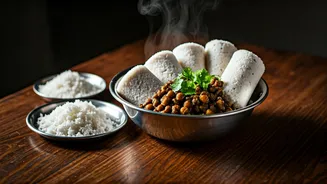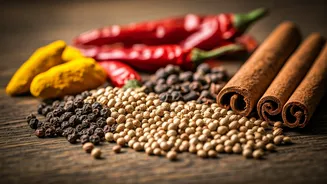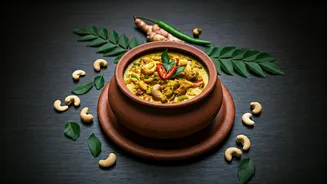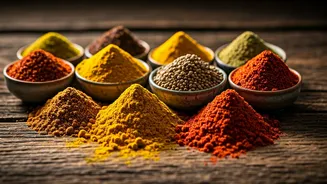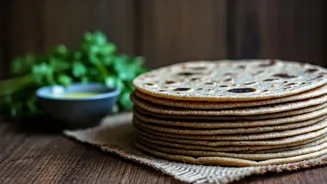Beetroot Pachadi's Zing
Beetroot Pachadi is a Kerala specialty that beautifully marries the sweetness of beetroot with the tang of yogurt, creating a refreshing side dish. The
beetroot is typically cooked until tender, then combined with a mixture of yogurt, mustard seeds, green chilies, and a touch of curry leaves for aroma. The mustard seeds, when tempered in oil, pop and add a distinctive crunch. This combination of flavors and textures—sweet, tangy, and subtly spicy—makes Beetroot Pachadi a delightful accompaniment to any meal. This dish is not just about taste; it also offers a vibrant color that brightens the dining table and provides valuable nutrients. It is a testament to how simple ingredients can be transformed into a culinary masterpiece, reflecting the Kerala style of utilizing fresh, seasonal produce. The process is easy, inviting home cooks to recreate the essence of Kerala’s cuisine without much effort.
Cabbage Thoran's Simplicity
Cabbage Thoran is a simple yet flavorful dish that highlights the crunch of cabbage, a common winter vegetable. Finely shredded cabbage is stir-fried with mustard seeds, curry leaves, and green chilies. The dish’s foundation rests on the use of grated coconut, which adds a layer of richness and a subtle sweetness that balances the spices. The cooking process is quick, ensuring the cabbage retains its crisp texture. The spices, typically including turmeric, add depth and color. Cabbage Thoran is a staple in Kerala households, easily paired with rice or roti. It's a prime example of how everyday ingredients can be transformed into a nutritious and satisfying meal, making it an excellent option for a light, healthy lunch or dinner. The simplicity of Cabbage Thoran makes it accessible for cooks of all skill levels, delivering a taste of Kerala's culinary heritage.
Amaranth Leaves' Goodness
Amaranth Leaves Thoran is another staple that beautifully features the nutritional benefits and subtle flavor of amaranth leaves. The preparation is similar to Cabbage Thoran. The leaves are stir-fried with a tempering of mustard seeds, curry leaves, and chilies. The grated coconut adds the required binding and richness. Amaranth leaves are high in vitamins and minerals, making this dish a nutritious addition to any meal. The cooking process is designed to preserve the leaves' tenderness, ensuring they don't become overly bitter. This preparation highlights how readily available greens can be transformed into delicious and wholesome meals. The dish often includes other spices like turmeric and a pinch of asafoetida. It's not just a dish; it's a celebration of health and flavor, highlighting Kerala's commitment to using seasonal greens.
Kerala Vegetable Stew's Creaminess
Kerala Vegetable Stew offers a comforting blend of winter vegetables simmered in a creamy coconut milk base. Common vegetables include potatoes, carrots, beans, and occasionally green peas or cauliflower. The stew is flavored with ginger, garlic, green chilies, and aromatic spices like cardamom and cloves. The cooking process involves gently simmering the vegetables until tender, allowing the flavors to meld beautifully. The coconut milk lends a velvety texture, making each spoonful a rich and satisfying experience. The stew is often seasoned with black pepper, and sometimes a touch of garam masala for an extra depth of flavor. It's a warming dish, perfect for cooler evenings, and it showcases the versatility of Kerala cuisine. Served with appam or rice, Kerala Vegetable Stew embodies the essence of comfort food.
Chena Erissery's Heartiness
Chena Erissery features chena (elephant foot yam), a root vegetable that adds heartiness and substance to this traditional Kerala dish. The chena is cooked and mashed with red chilies, cumin seeds, and coconut to create a flavorful paste. This paste is combined with the cooked yam, offering a semi-dry consistency. The dish is tempered with mustard seeds, dried red chilies, and curry leaves for a finishing touch. The combination of flavors and textures, with the chena’s earthy notes and the richness of coconut, makes it a unique offering. Chena Erissery is often prepared during festive occasions, symbolizing prosperity and good health. It highlights the use of diverse vegetables, which adds depth to Kerala’s culinary heritage. The dish reflects the culinary use of less-common vegetables with simple spices, demonstrating their versatility and deliciousness.
Mullangi Sambar's Tang
Mullangi Sambar uses radish, which provides a unique peppery tang to a flavorful South Indian lentil stew. The radishes are cooked with lentils (usually toor dal), tamarind pulp, and a blend of sambar powder, which includes spices such as coriander, cumin, and fenugreek. This combination imparts a characteristic aroma and taste. Other vegetables, such as drumsticks and tomatoes, are commonly added to enhance the flavor profile. The tempering of mustard seeds, dried red chilies, and asafoetida adds a finishing touch. Mullangi Sambar is a staple in Kerala, often served with rice, dosa, or idli. It's a balanced meal that offers protein, fiber, and essential nutrients. The use of mullangi adds a unique regional twist to this beloved dish, highlighting the local vegetable's utilization.
Cheera Parippu Curry's Simplicity
Cheera Parippu Curry beautifully blends spinach (cheera) with lentils (parippu), creating a nutritious and flavorful dish. The spinach is cooked with lentils, onions, tomatoes, green chilies, and a blend of spices, including turmeric and cumin. The lentils provide a creamy base and a boost of protein, while the spinach adds its earthy flavor and nutritional benefits. The dish is tempered with mustard seeds, dried red chilies, and curry leaves. Cheera Parippu Curry is a simple yet satisfying meal, suitable for both lunch and dinner. It represents Kerala's commitment to integrating greens into everyday meals. The dish is usually accompanied by rice. It exemplifies the balance of health and taste in Kerala’s cuisine, ensuring that every bite is not only delicious but also highly beneficial for your well-being.
Carrot Mezhukkupuratti's Sweetness
Carrot Mezhukkupuratti is a dry preparation that highlights the natural sweetness of carrots, a favorite vegetable during winters. Carrots are finely chopped and stir-fried with mustard seeds, curry leaves, green chilies, and turmeric. The dish can also include onions and garlic, which enhance the flavor. This cooking method focuses on retaining the carrots' slightly crunchy texture. The preparation is simple and quick, making it a perfect accompaniment to rice, roti, or any other main dish. This dish is usually served as a side or as part of a larger meal. It is a testament to the fact that simple ingredients, prepared with care and attention, can create a delicious and satisfying dish. Carrot Mezhukkupuratti is an example of the culinary expertise in Kerala, where simple ingredients are prepared with care.


